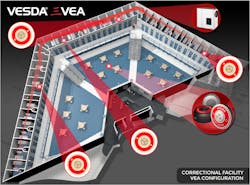Kern Valley State Prison Implemented System to Stop Nuisance Alarms and Speeds Smoke Detection
Under the guidance of the California Department of Corrections and Rehabilitation (CDCR), the largest nonfederal correctional system in the nation, Kern Valley State Prison is now joining a growing number of correctional facilities implementing aspirating smoke detection technology for fire protection.
Specified by the CDCR in the bidding process, aspirating smoke detection systems draw in air through small flexible tubing secured in air ducts. The air is analyzed continuously for the presence of minute smoke particles in a remote area up to 300’ away that is inaccessible to inmates.
This advanced technology not only provides faster, more sophisticated smoke detection, but also eliminates several costly and troublesome operational issues associated with traditional in-duct smoke detectors.
In some prisons, the problem is so severe nuisance alarms are ignored, even disconnected. In others, maintenance can become backlogged, leaving inmates effectively unprotected except for the vigilance of guards.
“Among traditional in-duct smoke detection systems, a large number of false alarms can be triggered when accumulated dust and dirt cover the sensors,” says Queen Gonzalez, a co-founder of Intelligent Fire Systems & Solutions, Inc., a Southern California based fire and life safety solutions company. Her company won the competitive public bid for the Kern Valley State Prison project involving aspirating smoke detection.
At Kern Valley State Prison, a Level IV facility in Delano, CA, Gonzalez says the fire safety project entailed replacing cell exhaust duct mounted smoke detectors with an advanced aspirating smoke detection system in an inmate housing unit. The scope of this involved about 16 pods, with about 64 cells per pod, for a total of nearly 1024 cells.
The aspirating smoke detection equipment chosen for the project was the VESDA-E VEA fire alarm system manufactured by Xtralis. The company is a global provider of early detection and remote visual verification of fire, gas and perimeter threats.
The air samples taken through the flexible tubes located in ductwork or return air chases are transported then analyzed using sophisticated laser-based technology at a central unit located within 300’. A single VEA system supports up to 40 sample points and can be extended to 120, if needed.
As a multi-channel, addressable system, the VEA central unit can pinpoint the exact location of the alarm. This can enhance safety by speeding detection, investigation, fire suppression, security management, and evacuation if necessary.
Furthermore, the VEA system offers earlier detection than photoelectric technology detectors. The system is able to detect minor particles in the air much faster, even before a fire begins to flame and burn.
For the project, 32 of the central units were used. These were located in a secure mechanical space behind the prison cells.
According to Gonzalez, it is a relatively simple installation. After each existing smoke detector is removed, tubing connected to air sampling points takes its place. This involved running tubing in the return air chase above all the cells. The tubing, suspended on hooks, drops off into each individual duct.
Another benefit of the system is that it can effectively deter inmate tampering, says Gonzalez.
“If there is a way for inmates to tamper with smoke detectors, they will,” says Gonzalez. “Inmates can even block ducts so in-duct smoke detectors will not work. Any system installed must be as tamper-proof as possible.”
To deter vandalism, the system will send a fault signal indicating the air flow is blocked in the event an inmate is able to cover a duct or sampling point.
“Even if prisoners could see the air sampling point, they would have no clue what it is because it is so small and looks nothing like a standard smoke detector,” adds Gonzalez.
Correction industry leaders also appreciate the very low maintenance required for aspirating smoke detection systems.
For instance, the VEA’s aspirating tubes are self cleaning and detect any blockages or breaks in the tubing. Even if dirt, dust, or lint enters the tubing system, the filters for all the sampling points are located at the central unit in a restricted area. Cleaning the filters takes only about a minute, so there is no need for maintenance personnel to crawl into ducts to clean the detectors.
The system not only stops false alarms due to dust or dirt contamination of sensors, but also can distinguish between smoke, fire, and other airborne contaminants, which further reduces nuisance alarms.
Annual National Fire Protection Association (NFPA) inspections are also simplified. Unlike traditional smoke alarms, systems like the VEA do not require testing of each sample point annually at its location in the duct. Instead, the tests can be conducted at the central unit.
Whether correctional facilities aim to minimize false alarms and maintenance or improve safety and security, aspirating smoke detection systems are gaining favor over traditional systems.
Kern Valley State Prison joins Corcoran State Prison in California as well as Fort Dodge Correctional Facility in Iowa and Pennsylvania Correctional Facility in adopting aspirating smoke detection.
Gonzalez, who is currently bidding on another aspirating smoke detection project for a prison in Arizona, concludes, “There is increasing interest in this technology, and it will only grow as more correctional facilities, engineers, and architects become aware of its benefits.”
Xtralis
For more information, contact Xtralis at 175 Bodwell Street, Avon, MA 02322, call: UK and Europe +44-1442-242-330; D-A-CH +49-431-23284 1; The Americas +1 (619) 252-2015; Middle East +962-6-588-5622; Asia +86-21-5240-0077; Australia and New Zealand +61 3 9936 7000, email: [email protected], [email protected] or visit www.xtralis.com/vea.
